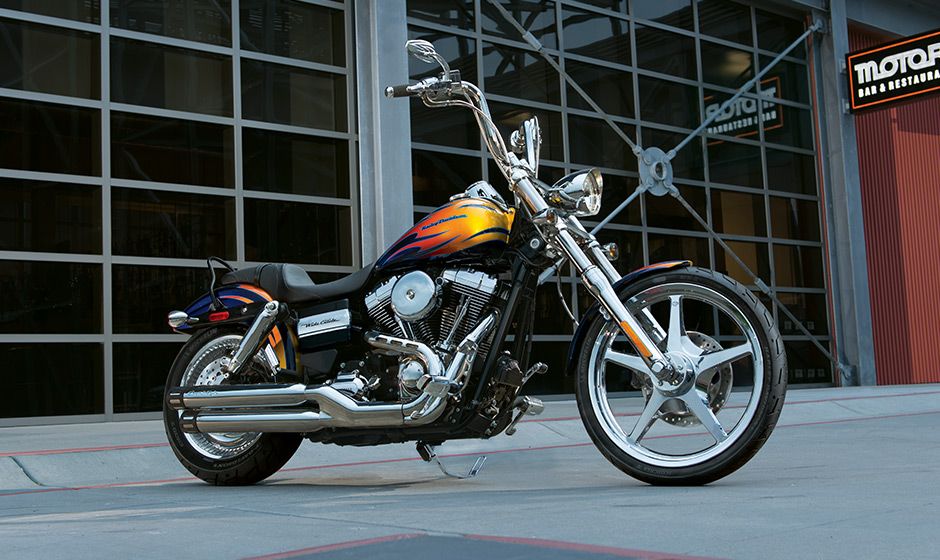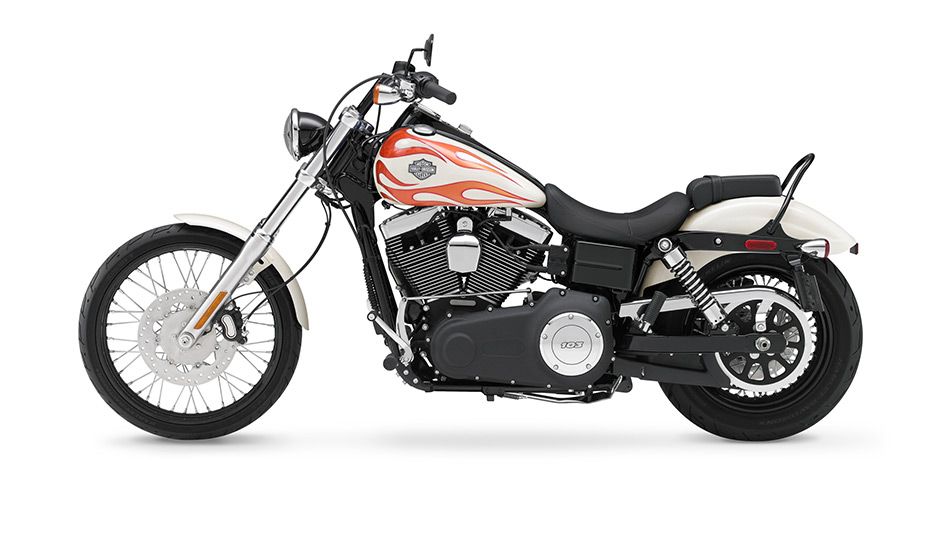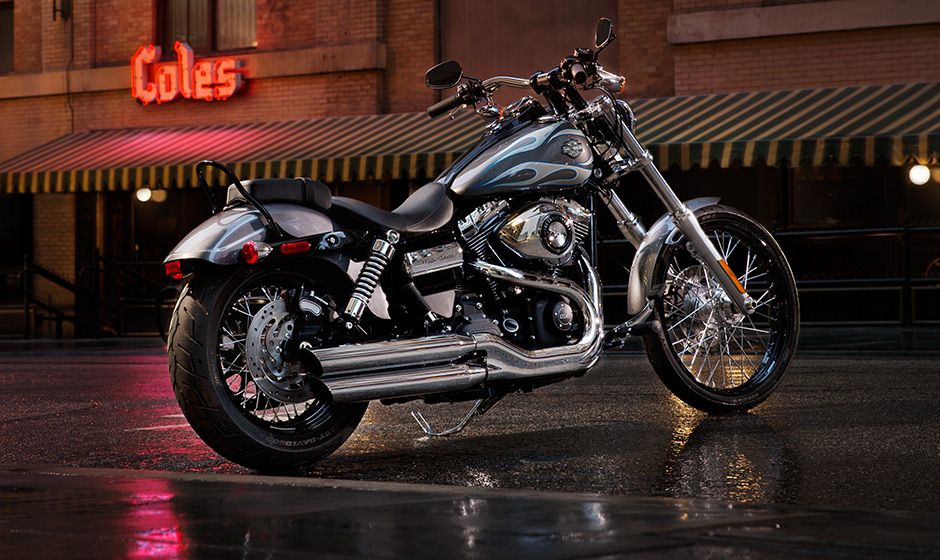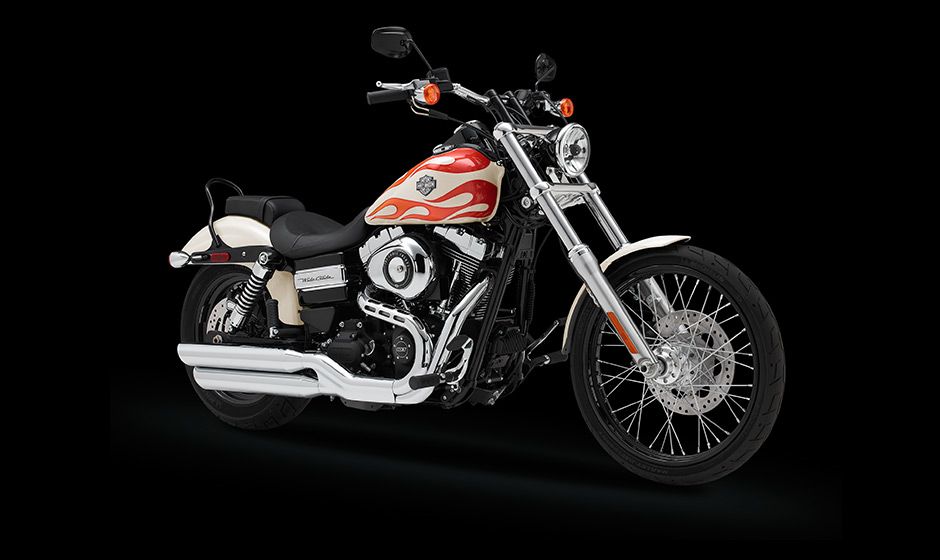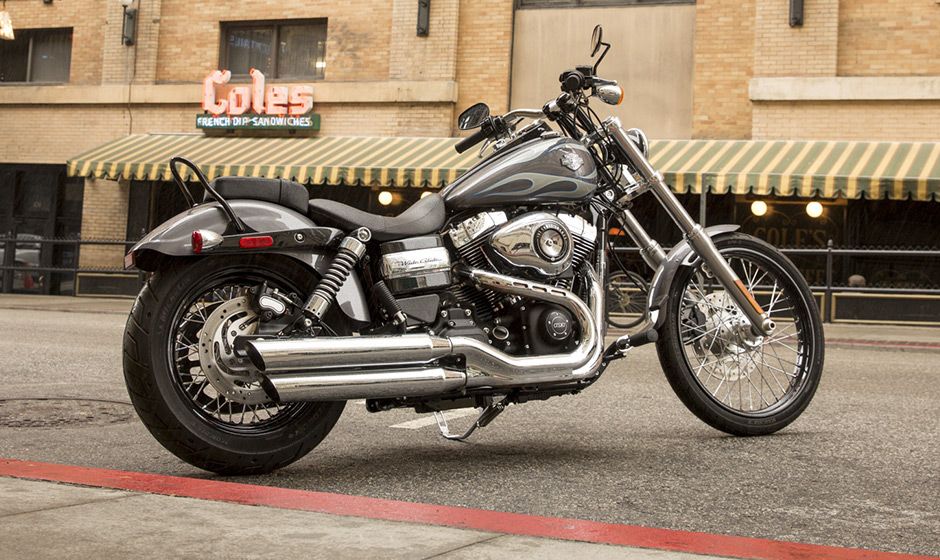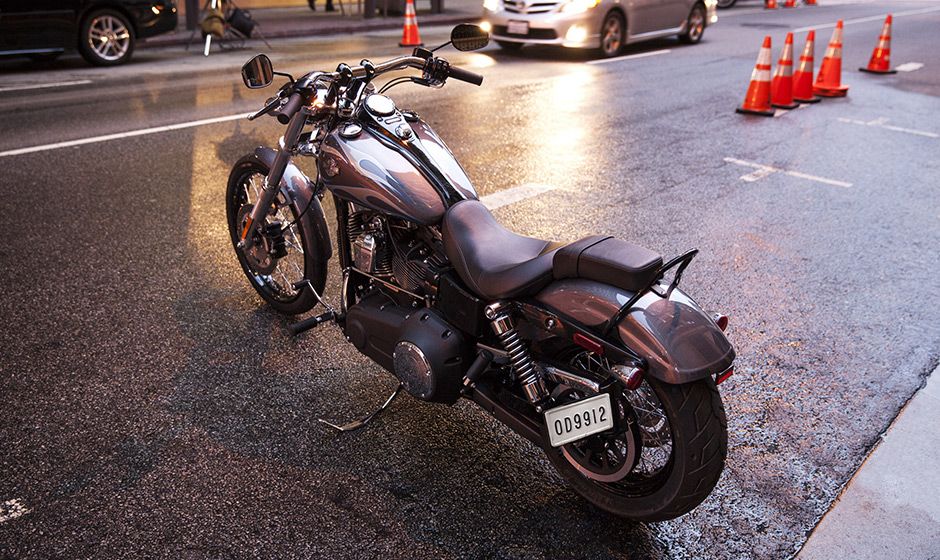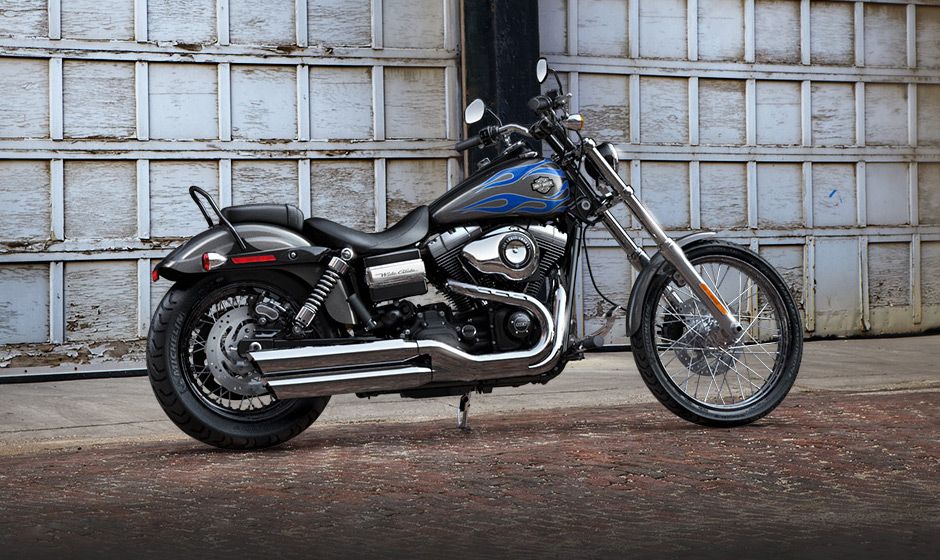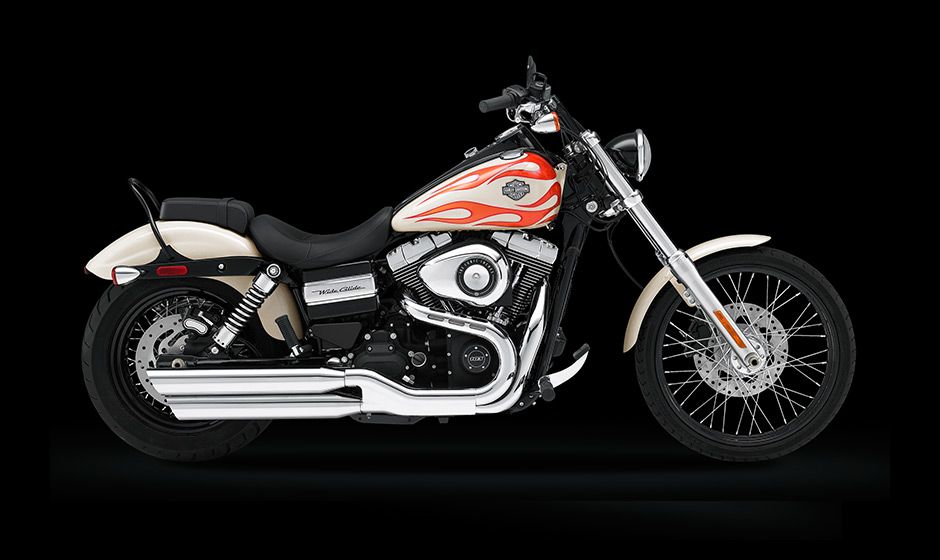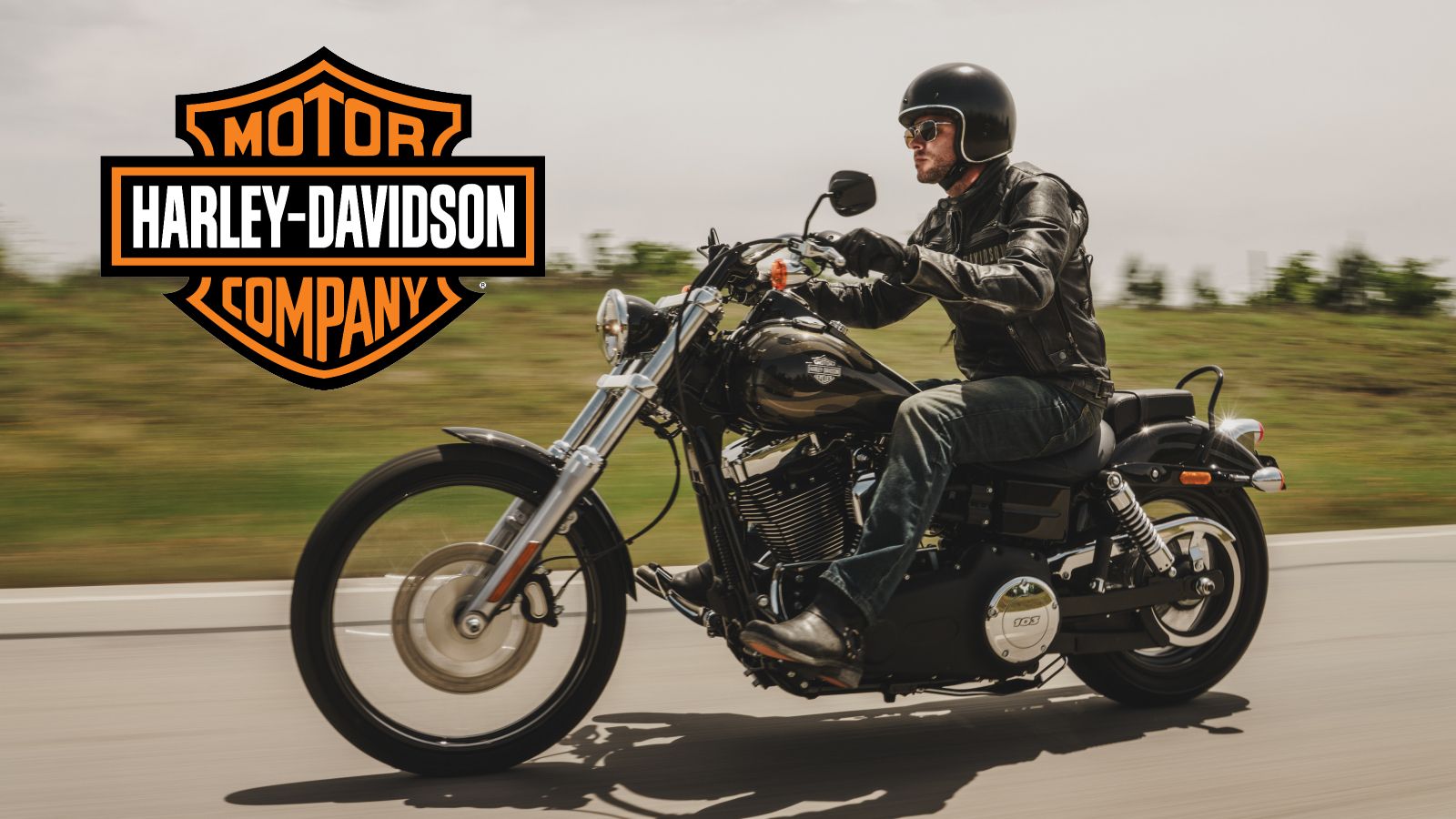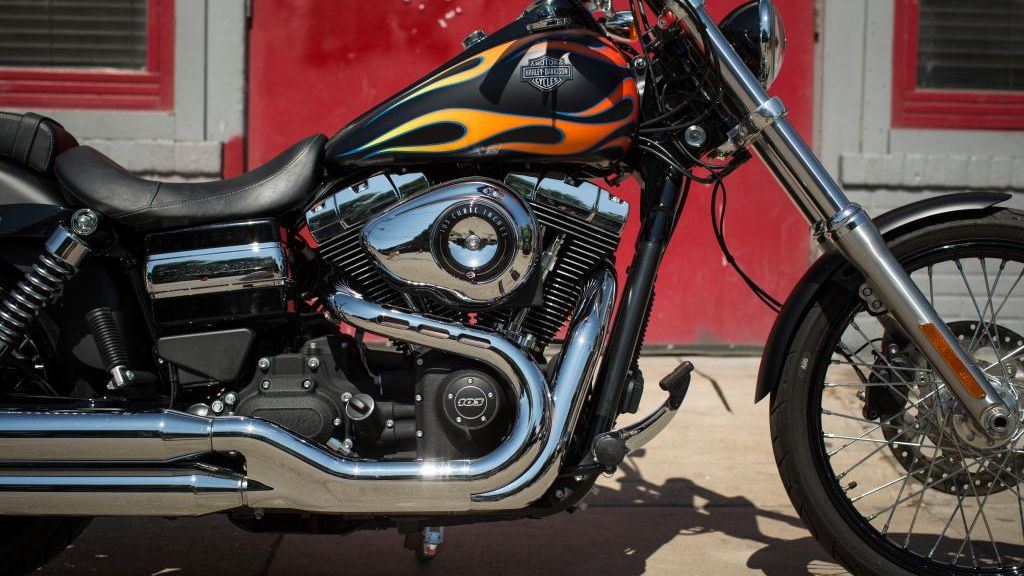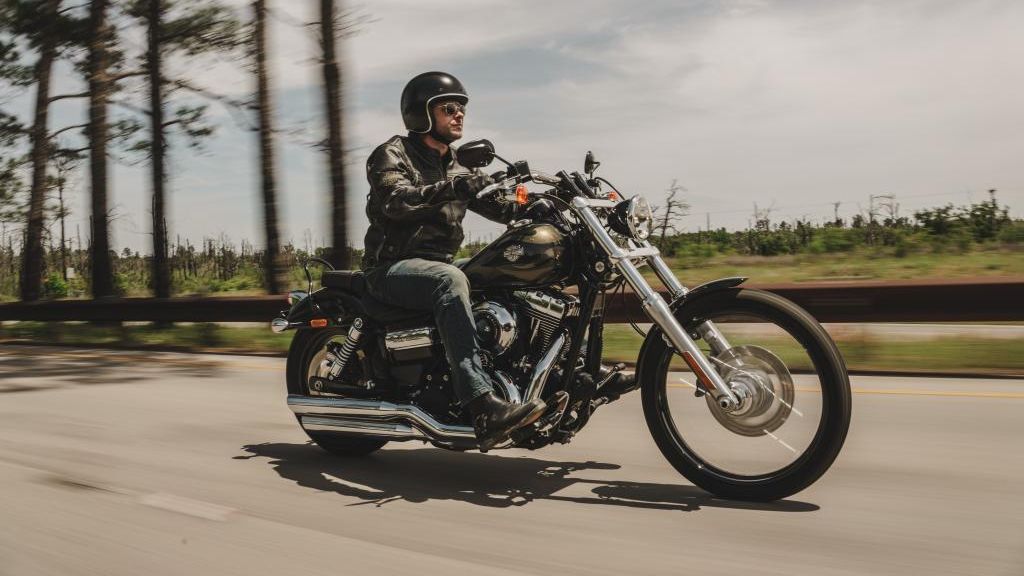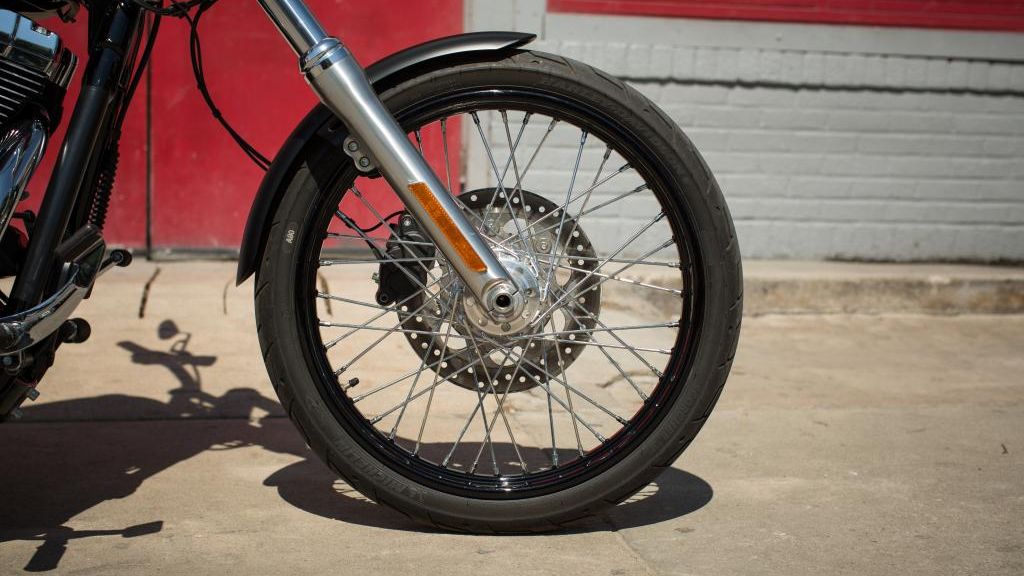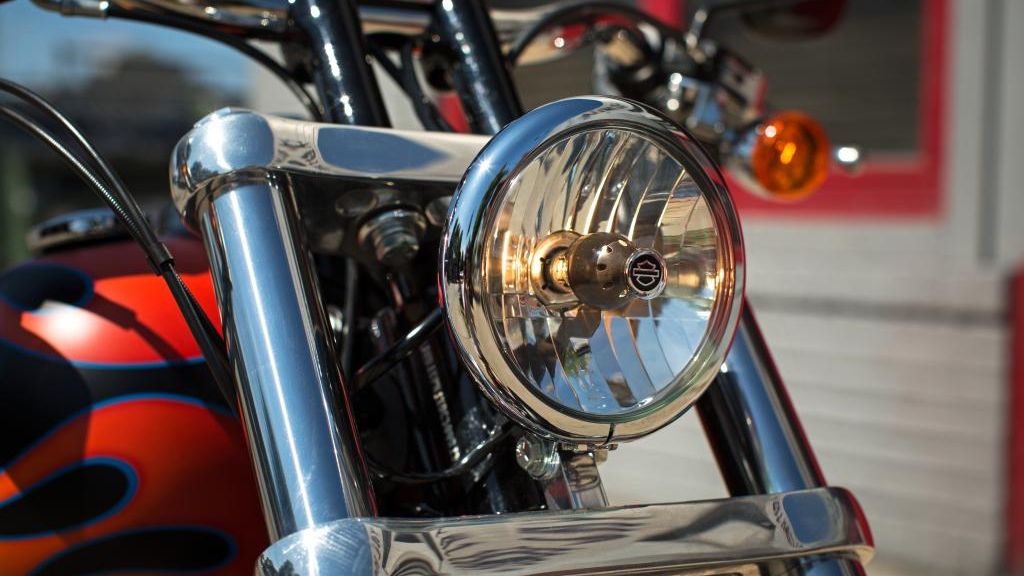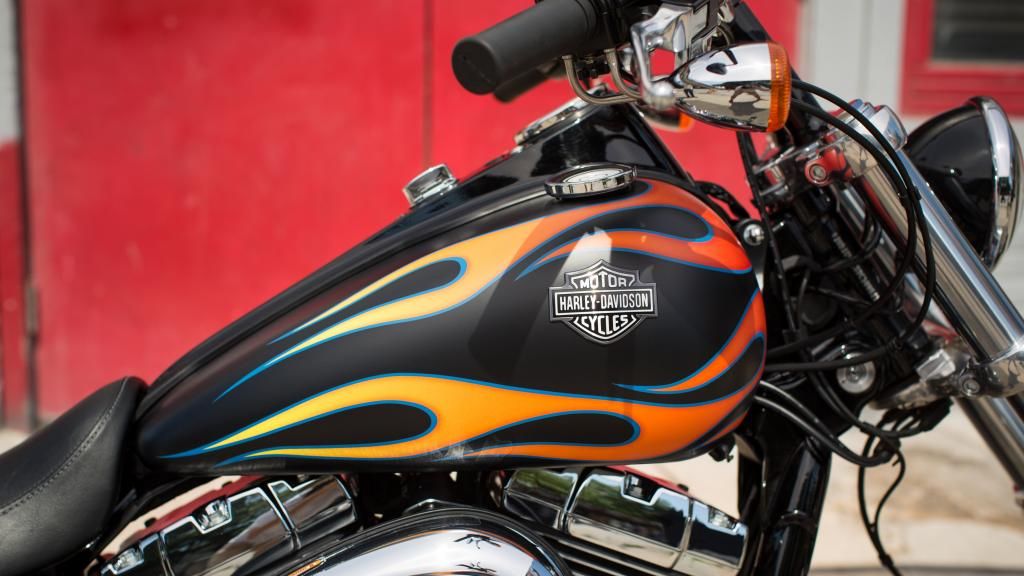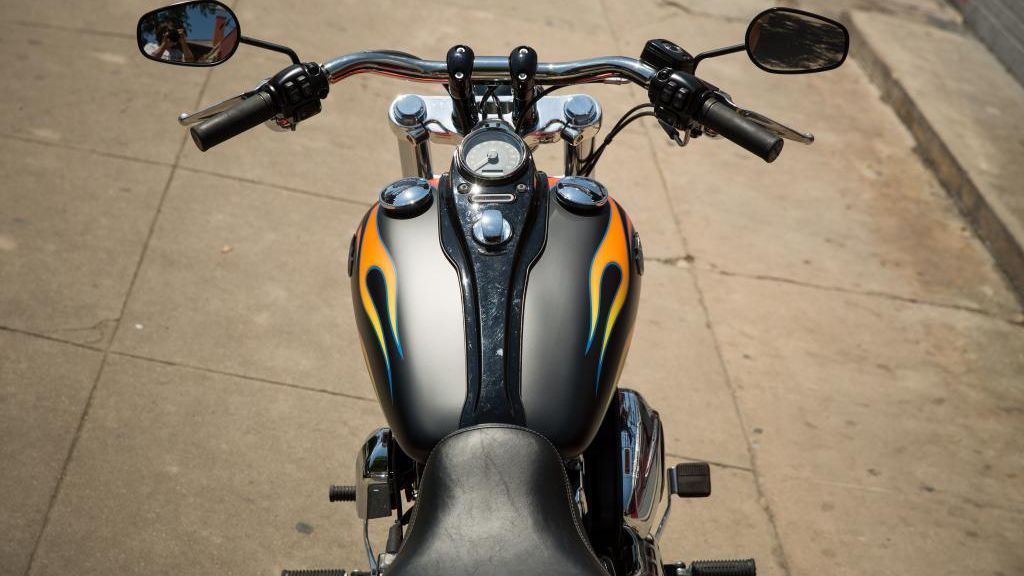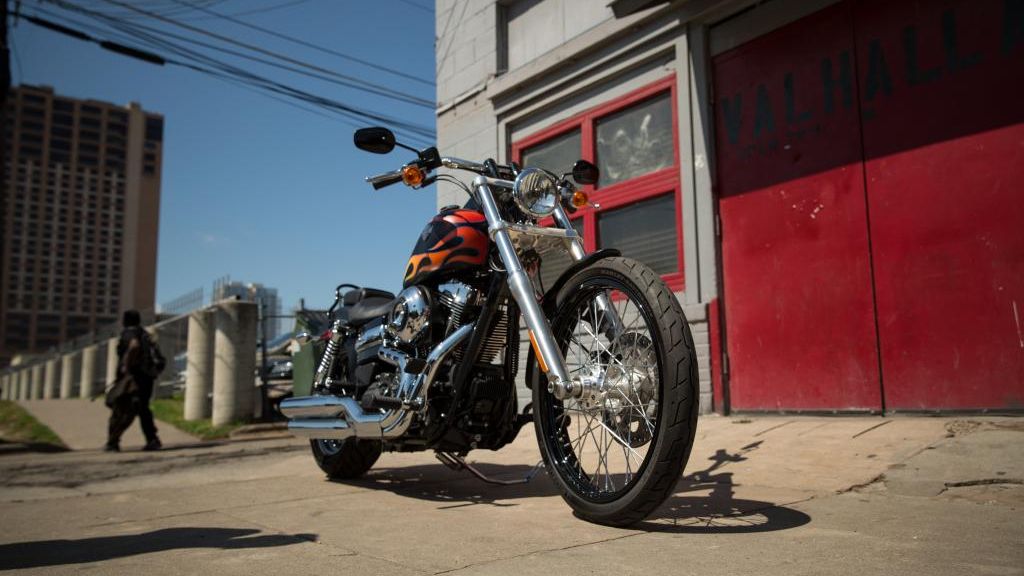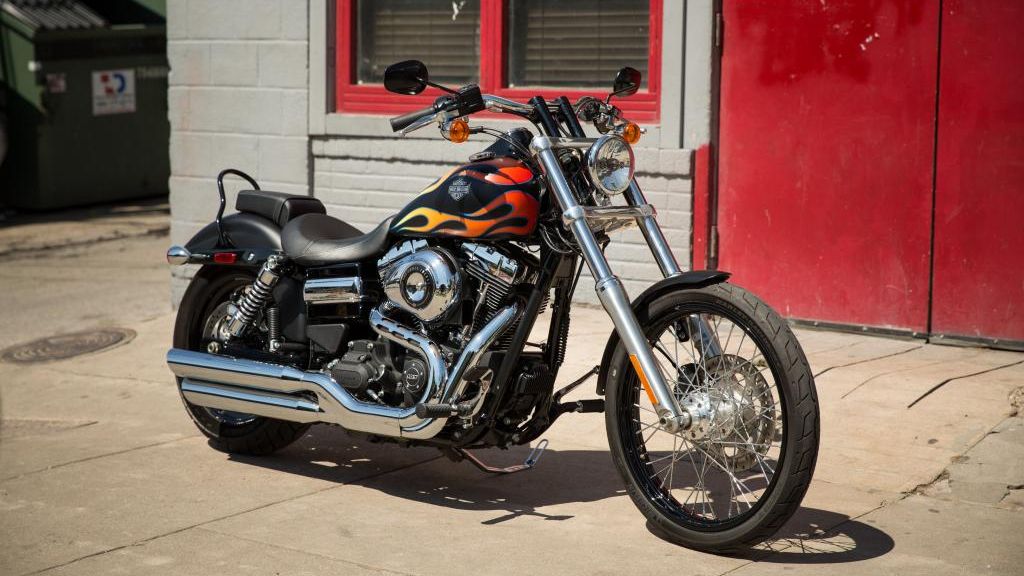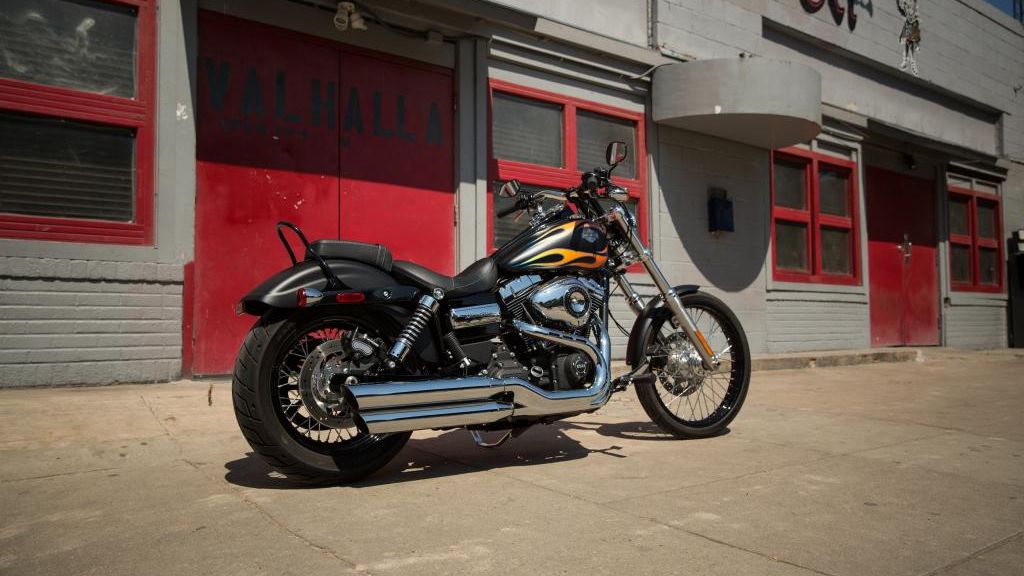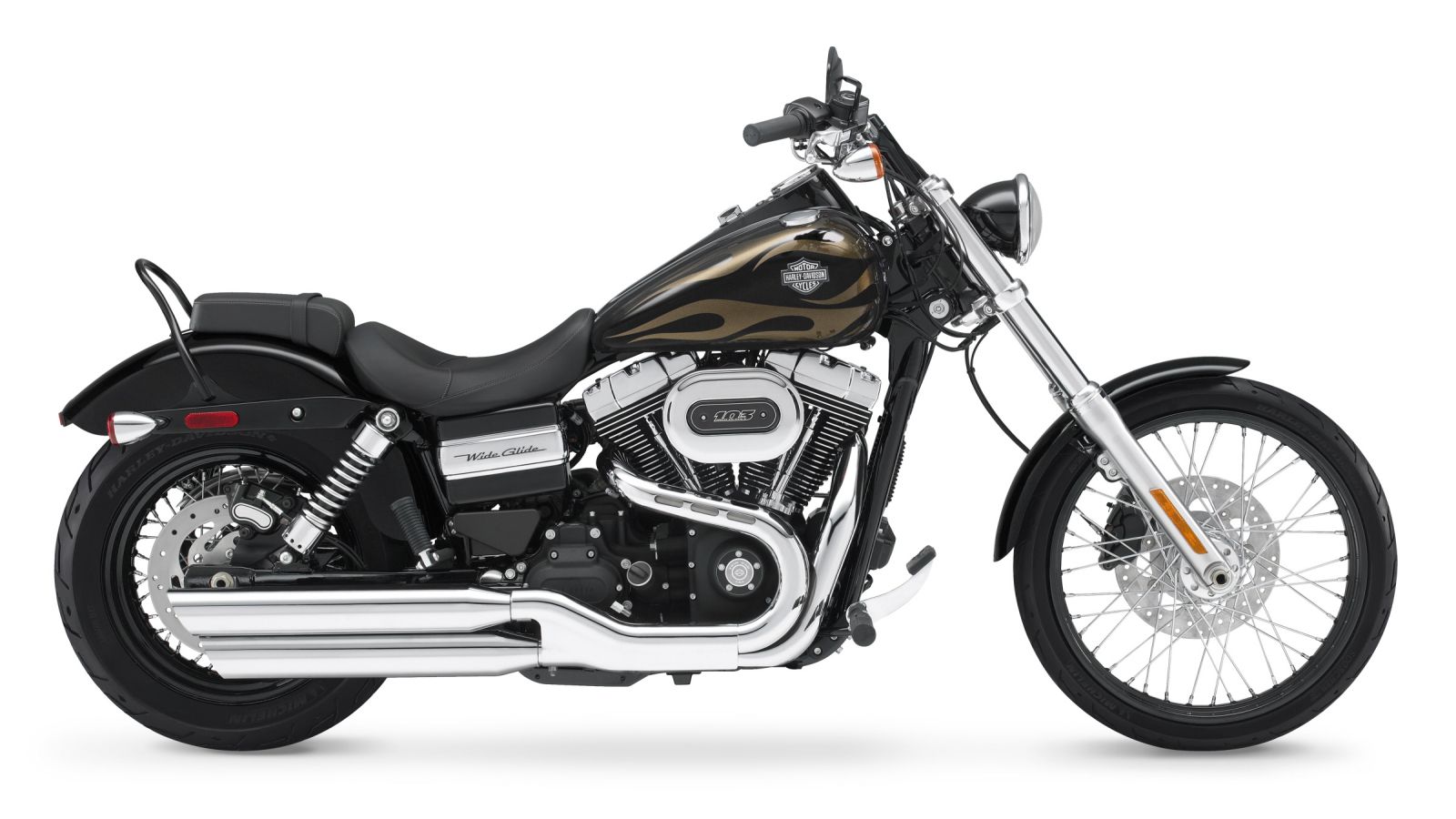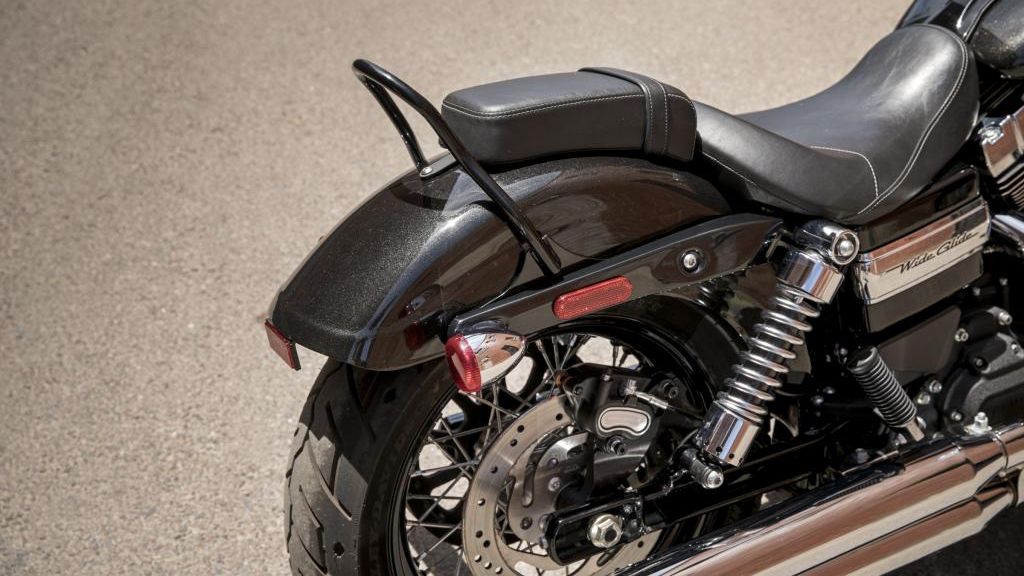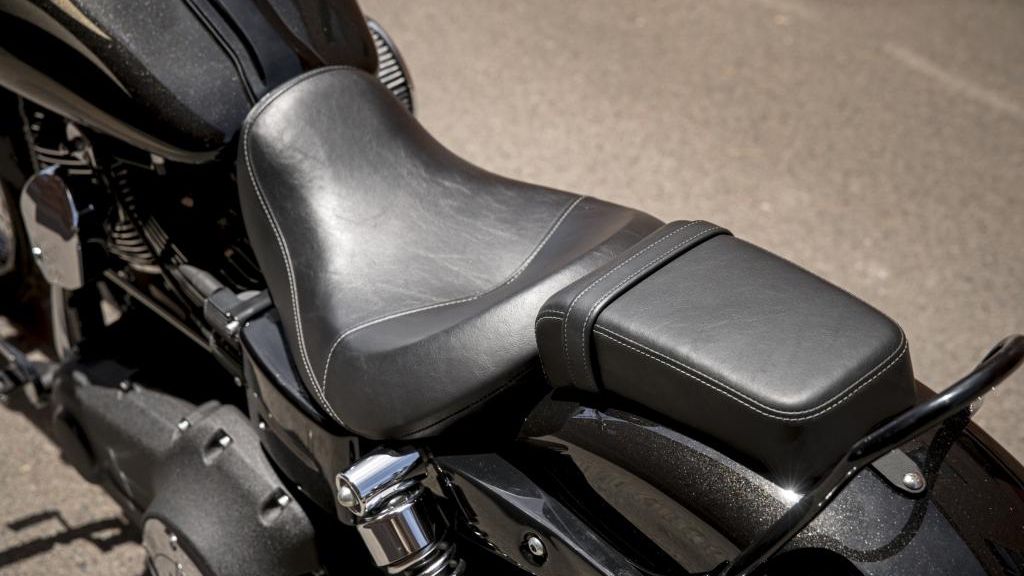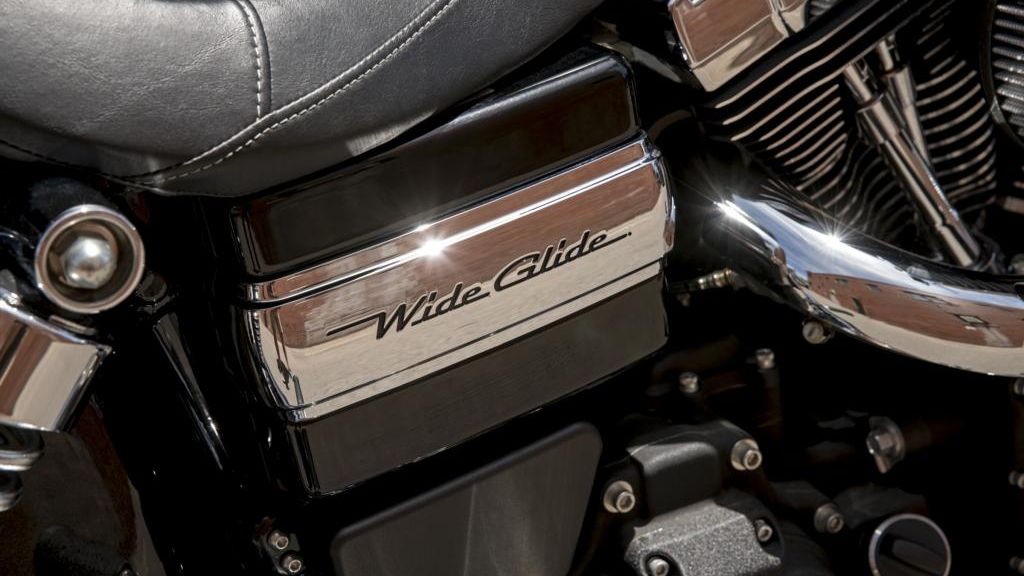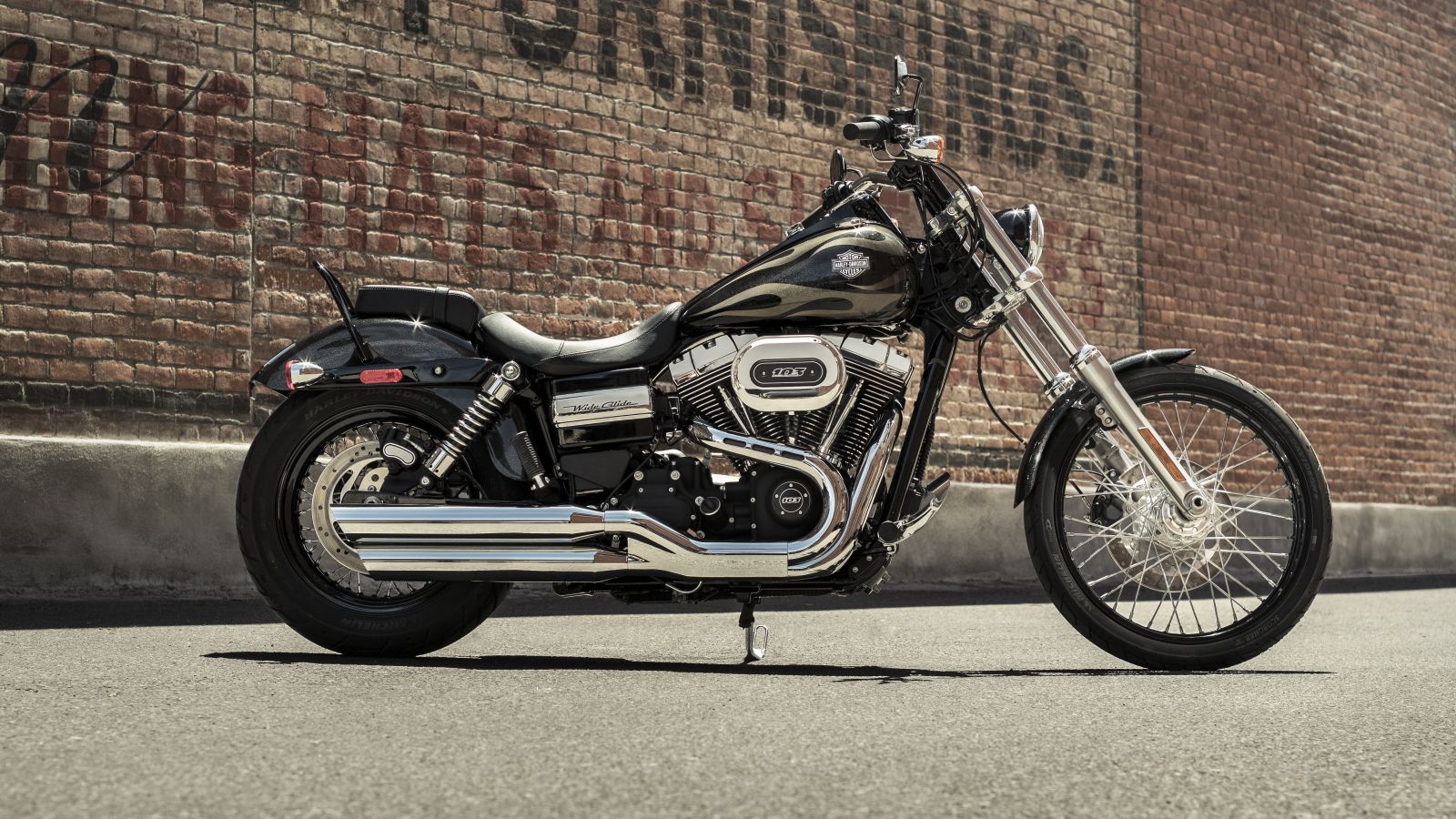What's wide up front, low in the back and round at both ends? That's right, its the FXDWG Dyna->ke1760 Wide Glide, Harley-Davidson->ke300's factory-custom->ke296 cruiser->ke392 that carries classic and custom design elements with none of the old-time nostalgia of some of their more retro-looking creations. In other words, less “grandpa” and more “club garage,” if you know what I mean.
Not exactly priced as an entry-level model, the DWG nonetheless serves as a viable “first upgrade” for folks looking to get off their trainer bike, and trade up to something with a little more fortitude. These rides are almost unchanged from 2014 through 2017 with the exception of paint and a few minor bits with an engine upgrade halfway through the range.
Continue reading for my review of the Harley-Davidson Dyna Wide Glide.
2014 - 2017 Harley Davidson Dyna Wide Glide
- Make: Array
- Model: 2014 - 2017 Harley Davidson Dyna Wide Glide
- Engine/Motor: High Output Twin Cam 103™
- [do not use] Vehicle Model: Array
Design
The DWG brings a strong custom influence to the table with proportions and features first designed by none other than Willie G. himself, and you can see that DNA coming and going. Head on, the widely spaced forks that give the model its name are plainly visible along with the beefy tripletree that locates the forks to define the look.
Handlebar-mount front turn signals leave the forks nice and clean with only the simple headlamp can to detract from that big, sexy front end. Blackout risers clamp a drag-style bar that pulls the rider forward somewhat with forward foot controls that place the rider fully into the windsock position; great for relaxed cruising, but for long trips, not so much.
The upper lines play across the tank-mounted instrument console that comes with electronic speedo, tach and fuel gauge complete with idiot light to name just a few of the functions. From there, the gentle slope meets the swale of the saddle and rear fender for a flatter backbone than say, a Softail->ke1819 for instance.
A fairly minimal P-pad and equally minuscule passenger retention bar (I can't call it a backrest, you ain't leaning back against this thing) finish out the rear end with an odd-looking bobbed fender. While the fender does fit with the whole custom theme, I never did like the mid-length look myself; either go with a full fender or chop that sucker all the way back to the struts, says I.
Chassis
As the “F” in FXDWG indicates, the Wide Glide starts out with Harley's big frame that boasts a heavy rectangular backbone for rigidity and torsional resistance with a double-downtube, double cradle engine section made from tubular, mild steel members. The steering head angle comes set at 34 degrees, pretty far out to start with, but a two-degree offset pushes the 49 mm forks even further out there for a total fork angle of 36 degrees, well into custom/chopper->ke2288 territory.
A standard, yoke-style swingarm finishes the bones with a pair of exposed, coil-over shocks to manage it. The shocks come with adjustable spring preload, but that's it, and the front forks aren't adjustable at all. I find it hard to believe Harley is still behind the curve on suspension technology. I mean, it's not like they have to invent the adjustable forks, just slap a set of existing adjustable tubes on there and run with it like everyone else does.
Oh well, it is what it is, and the components provide 5 inches of travel at the front axle and 3.1 inches at the rear for a fairly typical, H-D cruiser ride quality. Slammed rear shocks pull the rear end down for a low, 26.8-inch unladen seat height and minimal, 3.9 inches of ground clearance that gives you a 28.4-degree lean angle to the right because of the exhaust placement and a 31.9-lean to the left.
A single, four-pot caliper binds the 300 mm front disc, and a twin-piston caliper pinches the 292 mm rear disc with ABS as standard equipment across the board beginning in 2014. Now, this ride weighs in just North of 680 pounds so I have to question the decision to run only a single front brake. I know why they did it -- to avoid cluttering up that beautiful, 21-inch, laced front wheel -- but I question the wisdom of trading safety for vanity.
Drivetrain
The FXDWG has seen a couple of different engines in recent years. In '14 and '15, the factory tucked in its Air-Cooled Twin Cam 103, but the '16 and '17 year-models roll with the “High Output” version of the same engine. Honestly, I see the HO as just a marketing ploy since the base 103 Twin Cam puts out 98.8 pound-feet at 3,000 rpm, and the HO only adds a paltry 0.7 pound-feet for a total of 99.5 at 3,750. Go ahead and pencil me in as unimpressed with that increase, but still pleased with the overall performance that falls just a hair short of my threshold for “power cruiser->ke5323” status.
As you might imagine, this minuscule difference in power isn't indicative of any great mechanical differences between the two. Undersquare, the 3.87-inch bore and 4.374-inch stroke adds up to a total displacement of 103.1 cubic-inches with a 9.6-to-1 compression ratio that will allow you to pull up to the mid-grade pump.
An electronically controlled, fuel-injected throttle body manages the induction and helps to wring the combined city/highway mileage of 42 mpg out of these beasts. That's the good news. The bad news is that other than the optional Engine Idle Temperature Management Strategy, this mill comes with nothing in the way of electronic wizardry such as traction control or rider-selected power curves (unless you can find a Power Tuner somewhere, ahem), and so the engine is still pretty vanilla compared to some available on the market today.
A standard clutch couples engine power to the six-speed, Cruise Drive transmission, and Harley misses another opportunity to step up its game, especially since we already know they have a slipper clutch on the shelf. Granted, this isn't a performance bike by any stretch of the imagination, but I submit that every rider out there can appreciate the extra rear contact-patch protection and reduced effort at the lever.
A sweepy “Tommy Gun” exhaust brings the rear pipe forward around the nosecone (cam cover) before turning to the rear for even more custom flavor. H-D thoughtfully includes the pigtails for a battery tender as part of the '17 standard equipment, and although I ride enough to keep my battery hot, I realize not everyone has that luxury because of reasons, and so I guess I won't make fun of the pigtails....much. At least not here.
Pricing
MSRP on the '17 Wide Glide is on-par with what you would expect from Harley, which is to say a trifle on the high side at $15,999 for the Vivid Black sheet metal, and it goes up from there. The two-tone paint option boasts three different flame jobs from which to choose for $16,749, and seriously, who doesn't like flamejobs? The security option will set you back $395, and as always, California buyers take a $200 hit for their special emissions kit.
Competitors
While a direct comparison based on the overall look in general was easy enough, the wide, raked front end presented a bit of a challenge. Yamaha->ke301 gave me the best option here with its Raider->ke3143, so let's see how they stack up on paper.
The Raider may not have the widely spaced front forks of the FXDWG, but it does carry an abundance of rake with a 33-degree steering head and a 6-degree offset in the tripletree that kicks the forks on out to 39-degrees total. Not quite as cool as the Wide Glide front end, but still way cooler than stock.
A tank-mount instrument console and deep-scoop seat defines the upper lines of both rides, and while they both run chopped rear fenders, I gotta say I like the flare on the Raider as opposed to the shape of the Wide Glide's rear end. Sorry Harley, it looks a little too much like a genuine homejob with an almost random chop location, but maybe some folks will like it.
As heavy as the Wide Glide is, the Raider is even heavier at 734 pounds wet, which is probably why the Raider runs dual front brakes instead of a single like the Harley, but Yamaha offers no ABS on the Raider so I suppose it's a trade off. Personally, I'd rather have the dual front binders sans ABS, but that's just me.
Both rides run the typical, boring suspension so common in cruisers, so neither really gains an advantage here. The Dyna runs traditional, external shocks, but the Raider takes a page from the Softail playbook with a hidden shock that keeps the rear end lean and clean. As much as I like the clean rear end on the Raider, the chrome, coil-over shocks on the Dyna actually contributes to the look as well so it comes down to taste and preference. I can't decide which I like more.
Now for the beating hearts. Harley runs its 103-inch, HO Twin Cam that generates a respectable 99.5 pound-feet at 3,750 rpm, not too shabby, but Yamaha takes it up a notch with a massive, 113 cubic-inch V-twin that cranks out a punishing 123 pounds of grunt that comes on at a mere 2,500 rpm for a difference you can definitely feel, and the greater weight of the Raider isn't going to be enough to put much of a dent in that advantage, and so Yamaha scores big in the engine department.
The Tuning-Fork Company scores again at checkout, but not by as wide a margin as one might imagine. Harley prices the Dyna Wide Glide out at $15,999 -- more if you aren't into gloss black -- but the Raider commands a fairly high price as well with a $14,990 tag. That one-grand difference isn't likely to buy the Raider much love from someone that's already leaning Harley, but folks wanting this look, but not necessarily the Harley image, will likely find a friend in the Raider.
He Said
“I have never made secret my disdain for the Dyna family. The old FXR frame worked just fine, says I, and generally dislike the overall looks. All that goes out the window with the Wide Glide, which is actually one of my favorite Harleys, and has been since the first time I saw that wide front end comin' at me down the street. Old Willie really did a nice job laying it out back in the '80s, and I like how it makes classic, custom details sexy again. Who am I kidding, they've always been sexy, and I don't expect them to go out of style anytime soon.”
She Said
My wife and fellow motorcycle writer, Allyn Hinton, says, “I'm not a fan of that tight windsock position, probably because I'm short and I don't feel comfortable with my feet up that far, but it's a personal preference and I'm sure lots of folks will disagree with me. Seat height is low, as I expect it to be. I can reach the ground and still have a little break at the knee. I agree with my husband that I'd like to see a little more in the way of braking since the brakes feel a bit lacking. You really get the feel of sitting in the bike rather than on it and the saddle is quite comfortable, so an easy pick for around town or light touring.}
Specifications
|
DIMENSIONS: |
|
|
Length: |
96.3 in. (2445 mm) |
|
Overall Width: |
35.2 in. (895 mm) |
|
Overall Height: |
44.7 in. (1135 mm) |
|
Seat Height: |
|
|
Laden: |
25.5 in. (648 mm) |
|
Unladen: |
26.8 in. (680 mm) |
|
Ground Clearance: |
3.9 in. (100 mm) |
|
Rake (steering head): |
34° |
|
Fork Angle: |
36° |
|
Trail: |
5.2 in. (132 mm) |
|
Wheelbase: |
67.5 in. (1715 mm) |
|
Tires (Michelin® Scorcher® “31” front and rear): |
|
|
Front – Scorcher® “31”: |
80/90-21 54H |
|
Rear – Scorcher® “31”: |
180/60B17 75V |
|
Fuel Capacity: |
4.7 gal. (17.8 L) (warning light at approximately 0.9 gal.) |
|
Oil Capacity (w/filter): |
3 qt. (2.8 L) |
|
Transmission Capacity: |
1 qt. (.95 L) |
|
Primary Chain Case Capacity: |
1 qt. (.95 L) |
|
Weight: |
|
|
As Shipped: |
650 lb. (295 kg) |
|
In Running Order: |
683 lb. (310 kg) |
|
Gross Vehicle Weight Rating: |
1085 lb. (492 kg) |
|
Gross Axle Weight Rating: |
|
|
Front: |
390 lb. (177 kg) |
|
Rear: |
695 lb. (315 kg) |
|
ENGINE: |
|
|
Engine: |
Air-cooled, High Output Twin Cam 103™ |
|
Valves: |
Pushrod-operated, overhead valves with hydraulic, self-adjusting lifters; two valves per cylinder |
|
Bore x Stroke: |
3.875 in. x 4.374 in. (98.4 mm x 111.1 mm) |
|
Displacement: |
103.1 cu. in. (1690 cc) |
|
Compression Ratio: |
9.6:1 |
|
Fuel System: |
Electronic Sequential Port Fuel Injection (ESPFI) |
|
Air Cleaner: |
Ventilator intake with fiberglass media, washable exposed element with rain sock |
|
Lubrication System: |
Pressurized, dry-sump |
|
Primary Drive: |
Chain, 34/46 ratio |
|
Final Drive: |
Belt, 32/66 ratio |
|
Clutch: |
Multi-plate, wet |
|
Transmission: |
6-Speed Cruise Drive® |
|
Gear Ratios (overall) U.S.: |
|
|
1st: |
9.311 |
|
2nd: |
6.454 |
|
3rd: |
4.793 |
|
4th: |
3.882 |
|
5th: |
3.307 |
|
6th: |
2.79 |
|
CHASSIS: |
|
|
Frame: |
Mild steel, tubular frame; rectangular section backbone; stamped, cast, and forged junctions; forged fender supports; MIG welded |
|
Swingarm: |
Mild steel, rectangular tube sections, stamped junctions; MIG welded |
|
Front Forks: |
49 mm with polished aluminum fork triple clamp and dual-rate springs |
|
Rear Shocks: |
Coil-over shock |
|
Wheels: |
Black Steel Laced |
|
Front: |
21 in. x 2.15 in. (533 mm x 55 mm) |
|
Rear: |
17 in. x 4.5 in. (432 mm x 114 mm) |
|
Brakes: |
|
|
Caliper Type: |
4-piston front and 2-piston torque-free floating rear |
|
Rotor Type (diameter x width): |
Patented, uniform expansion rotors (floating, front only) |
|
Front (floating): |
11.8 in. x .2 in. (300 mm x 5.1 mm) |
|
Rear: |
11.5 in. x .23 in. (292 mm x 5.8 mm) |
|
Anti-lock Braking System: |
Standard |
|
Suspension Travel: |
|
|
Front Wheel: |
5 in. (127 mm) |
|
Rear Wheel: |
3.1 in. (80 mm) |
|
PERFORMANCE: |
|
|
Engine Torque (per J1349) North America: |
99.5 ft. lbs. @ 3750 RPM (135 Nm @ 3750 RPM) |
|
Lean Angle (per J1168): |
|
|
Right: |
28.4° |
|
Left: |
31.9° |
|
Fuel Economy (Combined City/Hwy): |
42 mpg (5.6 L/100 km) |
|
ELECTRIC: |
|
|
Battery (per Battery Council International Rating): |
Sealed, maintenance-free, 12V, 19-amp/hour, 270 cca |
|
Charging: |
Three-phase, 40-amp system (493W @ 13.5V, 2000 RPM, 540W max power @ 13.5V) |
|
Starting: |
1.2 kW electric with solenoid shift starter motor engagement |
|
Lights (as per country regulation): |
|
|
Headlamp (Quartz Halogen): |
55-watt low beam, 60-watt high beam |
|
Indicator Lamps: |
High beam, directional light bar, neutral, low oil pressure, engine diagnostics, turn signals, security system7 (optional), 6-speed, low fuel warnings |
|
Electric Power: |
Outlet Standard |
|
DETAILS: |
|
|
Warranty: |
24 months (unlimited mileage) |
|
Colors: |
|
|
2014: |
Vivid Black, Vivid Black with Flames, Blackened Cayenne with Flames, Morocco Gold Pearl with Flames, Charcoal Pearl with Flames |
|
2015: |
Vivid Black, Morocco Gold Pearl with Flames, Mysterious Red Sunglo with Flames, Black Quartz with Flames, Black Denim with Flames, Radioactive Green |
|
2016: |
Vivid Black with Med. Silver pinstripe, Charcoal Pearl with Faded Flames, Black Denim with Bright Flames, Black Quartz with Faded Flames, Velocity Red Sunglo with Faded Flames |
|
2017: |
Vivid Black with Med. Silver pinstripe, Black Denim with Bright Flames, Black Quartz with Faded Flames, Velocity Red Sunglo with Faded Flames |
|
Price: |
|
|
2014: |
Vivid Black: $15,799, Two-Tones: $16,529 |
|
2015: |
Vivid Black: $15,799, Flame: $16,549, Custom Color: $16,749 |
|
2016: |
Vivid Black: $15,999, Flame: $16,749 |
|
2017: |
Vivid Black: $15,999, Two-Tone Option: $16,749 |

